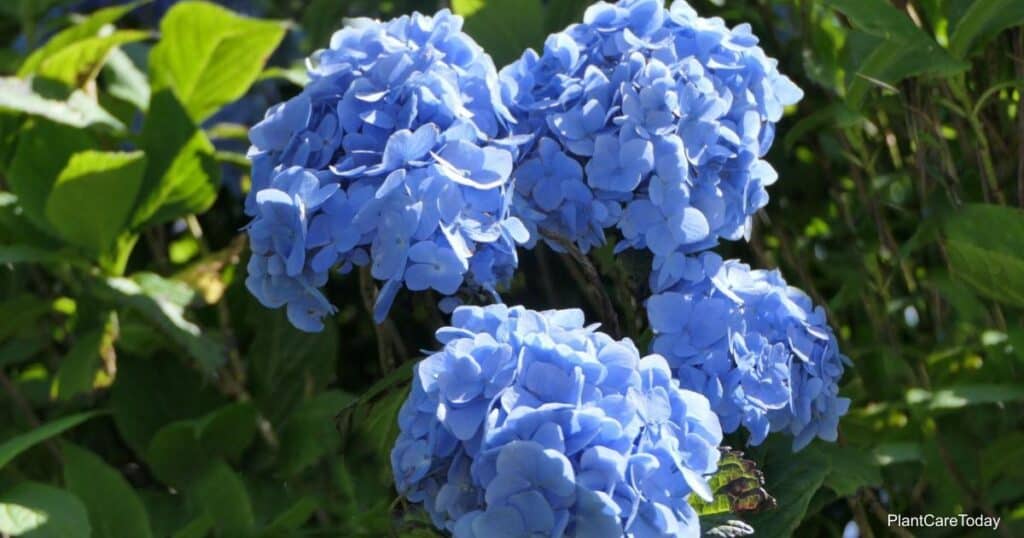Hydrangeas like rich, loamy, well-draining soil that is generously amended with organic matter, such as coffee grounds, natural compost, shredded leaves, etc.
The soil mix should have the ability to retain enough water to stay slightly damp without allowing water to stand.

Best Hydrangea Soil Q&A
1. Do Hydrangeas Like Clay Soil?
Although some sources recommend clay soil for hydrangeas because of its water-retaining abilities, it must be amended with organic matter.
Hard, compacted clay soil allows water to stand. However, it does not allow for healthy root growth and will tend to cause root rot.
Clay soil may form a good basis for your soil mix, but you must be sure to incorporate plenty of organic matter to improve its texture, drainage, and ability to deliver nutrients to your plants.
2. Do Hydrangeas Like Sandy Soil?
Generally speaking, Hydrangeas need soil with good water retention properties to produce copious blooms, so sand is not particularly desirable.

Oakleaf and Smooth Hydrangeas have lower water needs than other types, so they can do better in sandy soil than some of their kin.
Their ability to grow in sandy soil is more of a tolerance than a preference.
3. How Do You Create A Good Soil Mix For Hydrangeas?
The key to good Hydrangea soil is plenty of natural organic matter.
One of the best ingredients to use as a basis for your hydrangea mix is aged manure and organic compost.
Organic matter lightens the soil, improves drainage, and supports the growth of microorganisms and earthworms that enhance the quality of the soil on an ongoing basis.
4. How Much Organic Matter Should You Add To The Soil?
Depending on the quality of your garden soil, you should add about one part organic matter to two parts soil.

If the soil is very heavy and compacted, don’t be afraid to add more. Your end result should be light, airy, and loose.
5. Should I Add Peat To My Hydrangea Soil Mix?
Peat moss is a classic form of organic matter that can be added to poor-quality soil to help improve drainage while simultaneously retaining the right amount of moisture.
However, it is worth noting that the collection of peat moss is not an earth-friendly activity, and peat moss is not a renewable resource.
Coco coir is a readily available, excellent alternative to peat.
It is the by-product of the processing of coconuts for the commercial market, so there is plenty of it, and it is quite affordable.
It is also worth noting that peat moss reduces soil pH levels. Coco coir is neutral and does not affect soil pH levels.
6. What Is The Best Soil pH Level For Hydrangeas?
The mid-range (5.5 to 8.0) is good. Above or below these pH levels is inadvisable because Hydrangeas cannot survive at pH levels at either extreme end of the spectrum.

If you are growing Bigleaf Hydrangeas, the pH level will affect the flower colors, but other types are not affected in this way.
For most of these plants, a pH level of 6.0 to 7.0 is best.
7. Why Does pH Level Affect Bloom Color In Bigleaf Hydrangeas?
This variety of Hydrangeas will tend to produce blue flowers when the soil’s pH level is more acidic (6.5 and above).
The flowers tend to be pink if it is more alkaline (below 6.5). The reason lies in the amount of aluminum the plant can uptake from the soil. [source]
It’s important to note that this doesn’t work for all Bigleaf Hydrangeas. Some varieties simply produce white flowers no matter what.
If you want to play with color, be sure to read the plant description carefully when purchasing Hydrangeas.
8. Can You Just Use Regular Potting Soil For Hydrangeas In Containers?
Yes, good quality potting soil or container plant soil should be fine for hydrangeas in containers.
Be sure that the container has plenty of drainage holes at the bottom.
You may wish to put a layer of finished compost or mulch over the soil’s surface to help retain water.
